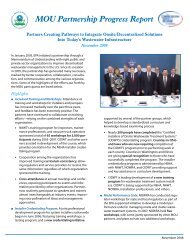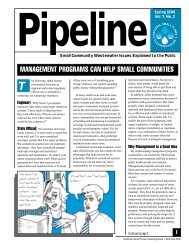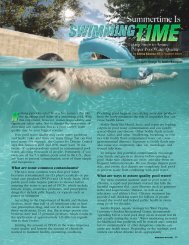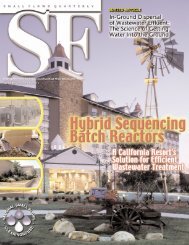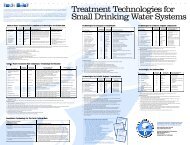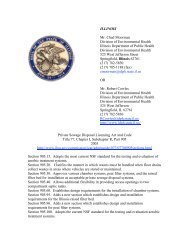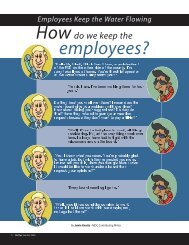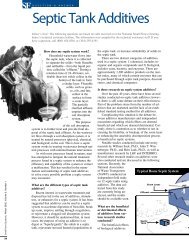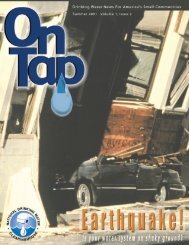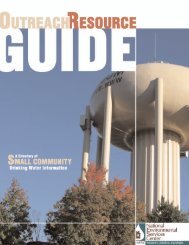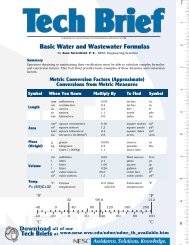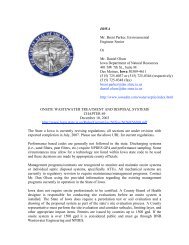RCAP Brochure PPCP 08 - National Environmental Services Center
RCAP Brochure PPCP 08 - National Environmental Services Center
RCAP Brochure PPCP 08 - National Environmental Services Center
You also want an ePaper? Increase the reach of your titles
YUMPU automatically turns print PDFs into web optimized ePapers that Google loves.
<strong>RCAP</strong><br />
“Improving the quality of life in rural communities”<br />
The U.S. <strong>Environmental</strong> Protection<br />
Agency offers basic information and<br />
answers to some frequently asked<br />
questions on their Web site at<br />
www.epa.gov/ppcp.<br />
An extensive article about drugs<br />
in drinking water, researched by the<br />
Associated Press, can be found at<br />
www.cnn.com/20<strong>08</strong>/HEALTH/03/10/<br />
pharma.water1/index.html.<br />
The Safe Drinking Water Trust<br />
eBulletin, produced by the Rural<br />
Community Assistance Partnership,<br />
featured an article about <strong>PPCP</strong>s in<br />
their 4/23/<strong>08</strong> issue.It can be found at<br />
www.watertrust.org/feature_article.a<br />
sp?nID=103<br />
The <strong>National</strong> <strong>Environmental</strong><br />
<strong>Services</strong> <strong>Center</strong>’s Winter 2007<br />
Pipeline newsletter Pharmaceutical<br />
and Personal Care Products: An<br />
Overview is available online at<br />
www.nesc.wvu.edu or by calling<br />
800-624-8301 for a free copy.<br />
This publication was made possible by Grant Number 90EF0066 from the Office of Community<br />
<strong>Services</strong>, Department of Health and Human <strong>Services</strong>.<br />
Its contents are solely the responsibility of the authors and do not necessarily represent the<br />
official views of the Office of Community <strong>Services</strong>, Department of Health and Human <strong>Services</strong>.<br />
Some images in this publication<br />
© 2003-<strong>08</strong> www.photos.com.
cientific evidence shows that a growing number of<br />
drugs and chemicals found in personal care products<br />
are ending up in waterways across the country. The<br />
potential for harm to human health is not known at this<br />
time, but because drinking water is drawn from these same<br />
sources, there is a growing concern about how these drugs<br />
and other substances may be affecting people, especially with<br />
long-term exposure. To protect our drinking water and our<br />
health, it makes sense that we reduce the amount of these<br />
<strong>PPCP</strong>s in our wastewater as much as possible.<br />
Federal guidelines 1 recommend three ways to dispose of<br />
prescription drugs:<br />
Take unused drugs and medicines to a “community<br />
pharmaceutical take-back program” that allows the<br />
public to bring unused drugs to a central location<br />
for proper disposal.<br />
Do not flush unused portions of drugs and medicines<br />
down the toilet, except where the label or<br />
instructions indicate to flush.<br />
Throw them in the trash, but only after taking<br />
them out of their original bottle, making them<br />
unpalatable by mixing them with wet coffee<br />
grounds, glue or kitty litter, and putting them in a<br />
leak-proof container.<br />
Lotion, soaps, sunscreen, shampoo and perfume all wash<br />
off easily when we shower, bathe or go swimming. These<br />
chemicals end up in our waterways also, and little is known<br />
about the effect they may have. We can make conscientious<br />
choices to buy products that contain only biodegradable or<br />
natural ingredients. People are also urged to avoid purchasing<br />
consumer products that are labeled “antibacterial” to<br />
lessen the likelihood of resistant microorganisms increasing<br />
in the environment.<br />
1. Office of <strong>National</strong> Drug Control Policy: www.WhiteHouseDrugPolicy.gov<br />
<strong>PPCP</strong>s are pharmaceuticals and personal care products such as drugs<br />
lotions, soaps, cosmetics and perfumes. <strong>PPCP</strong>s can be washed off,<br />
flushed, or poured down the drain and into our waterways.<br />
<strong>PPCP</strong>s also include veterinary medications,<br />
such as hormones and antibiotics used to<br />
treat livestock. These compounds are<br />
excreted by animals and can leach into<br />
groundwater and nearby rivers, lakes, ponds<br />
or streams and contaminate water supplies<br />
for surrounding farms and communities.<br />
When people take medications, some of the compounds are<br />
absorbed, but many are not. They pass through the body and are<br />
flushed down the toilet.<br />
$200.7 billion was spent in the U.S. for prescriptions in 2005,<br />
almost five times the amount spent in 1990. Currently, nearly<br />
65% of Americans take prescription drugs.<br />
It is estimated that every day people<br />
use between 9 and 15 personal care<br />
products and apply an average of 126<br />
different ingredients to their skin.<br />
Wastewater treatment plants are not specifically designed to<br />
remove <strong>PPCP</strong>s from the water that they treat and discharge into<br />
our waterways.<br />
Researchers have found male fish with female<br />
sex characteristics and some fish with both<br />
male and female reproductive organs in some<br />
contaminated waterways, and are investigating<br />
whether this is caused by <strong>PPCP</strong>s.<br />
There is currently no federal requirement for testing drinking<br />
water supplies for <strong>PPCP</strong>s.<br />
Most bottled water distributors do not necessarily test or treat<br />
their water for <strong>PPCP</strong>s.




